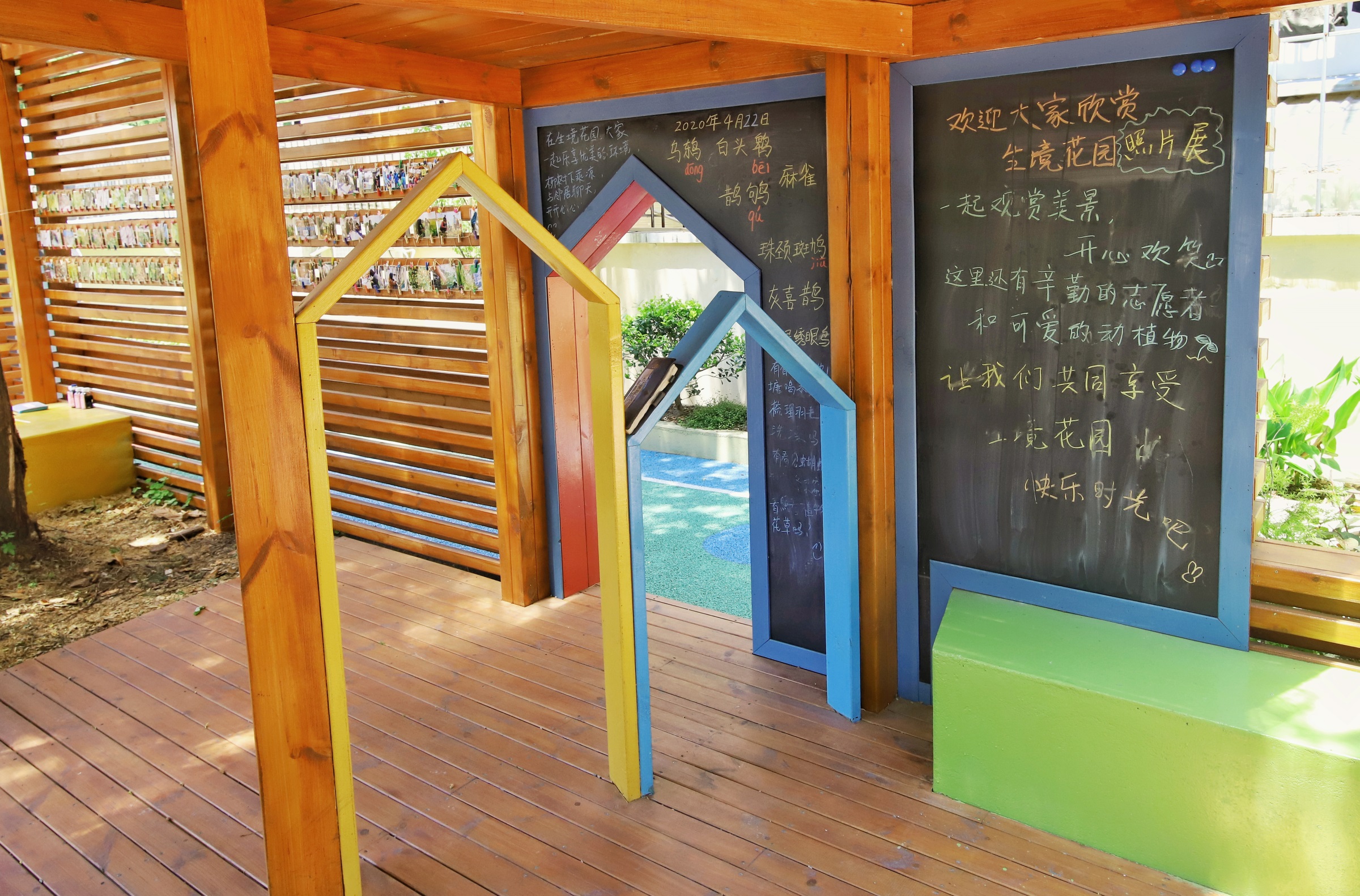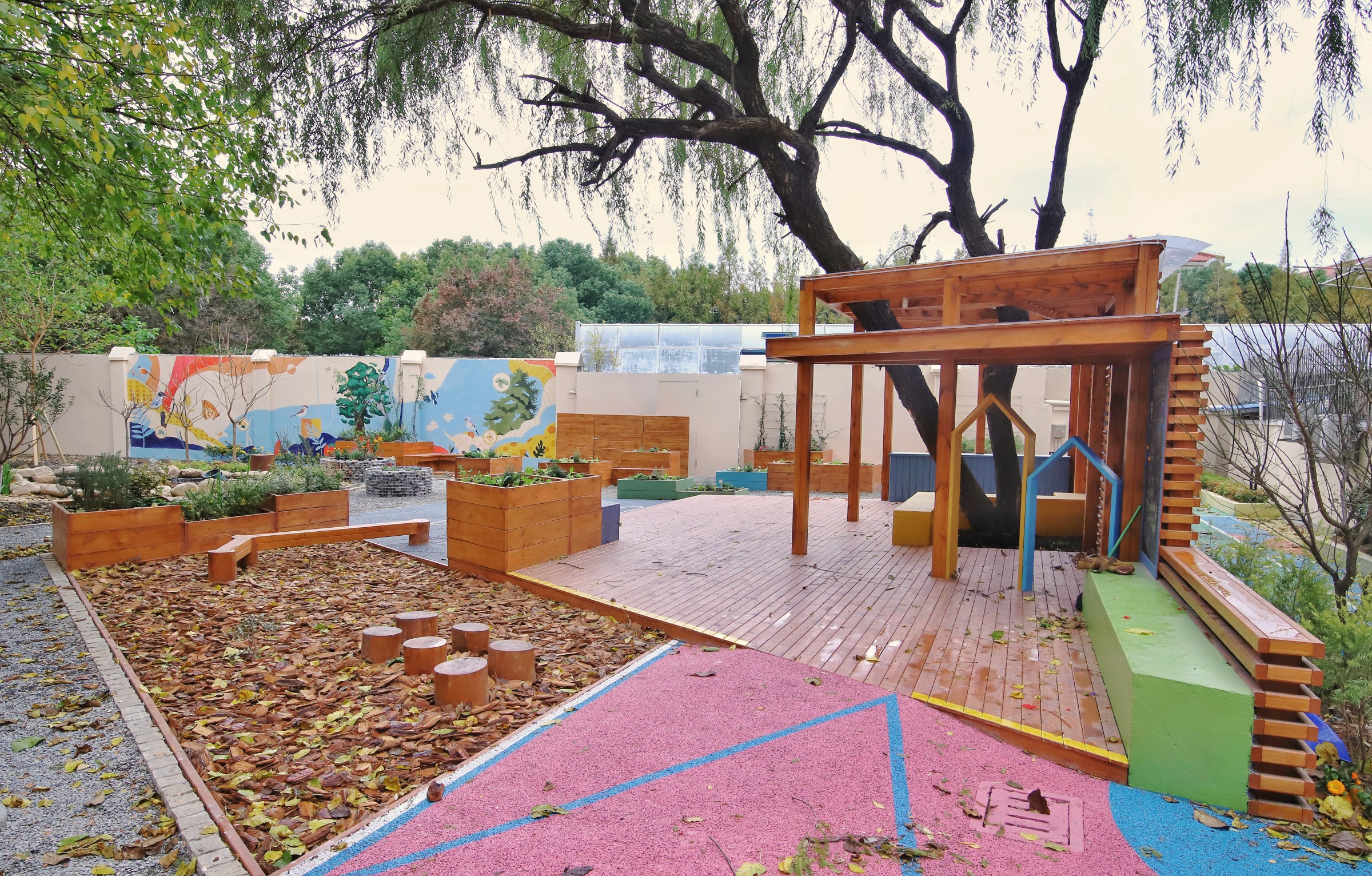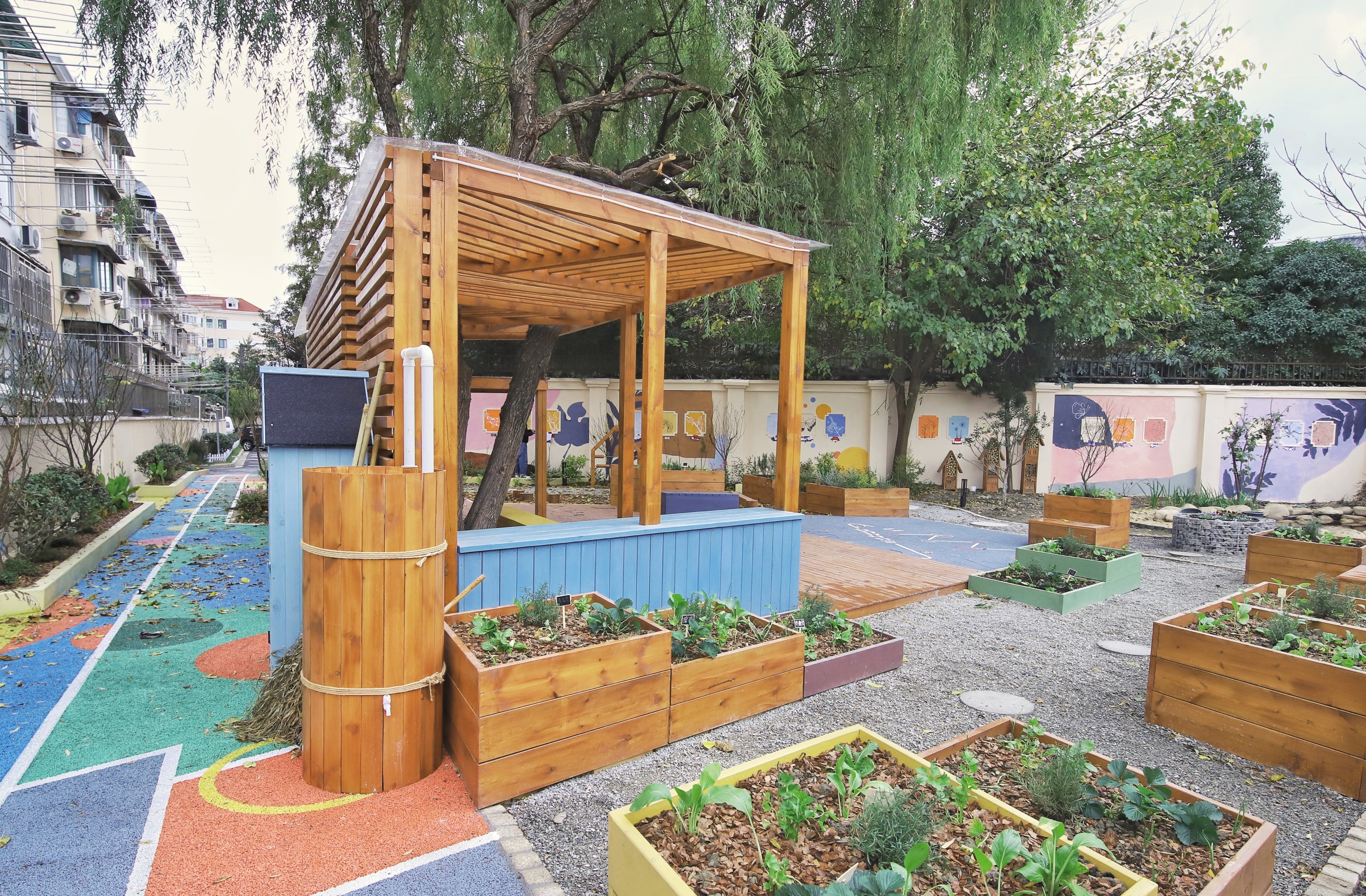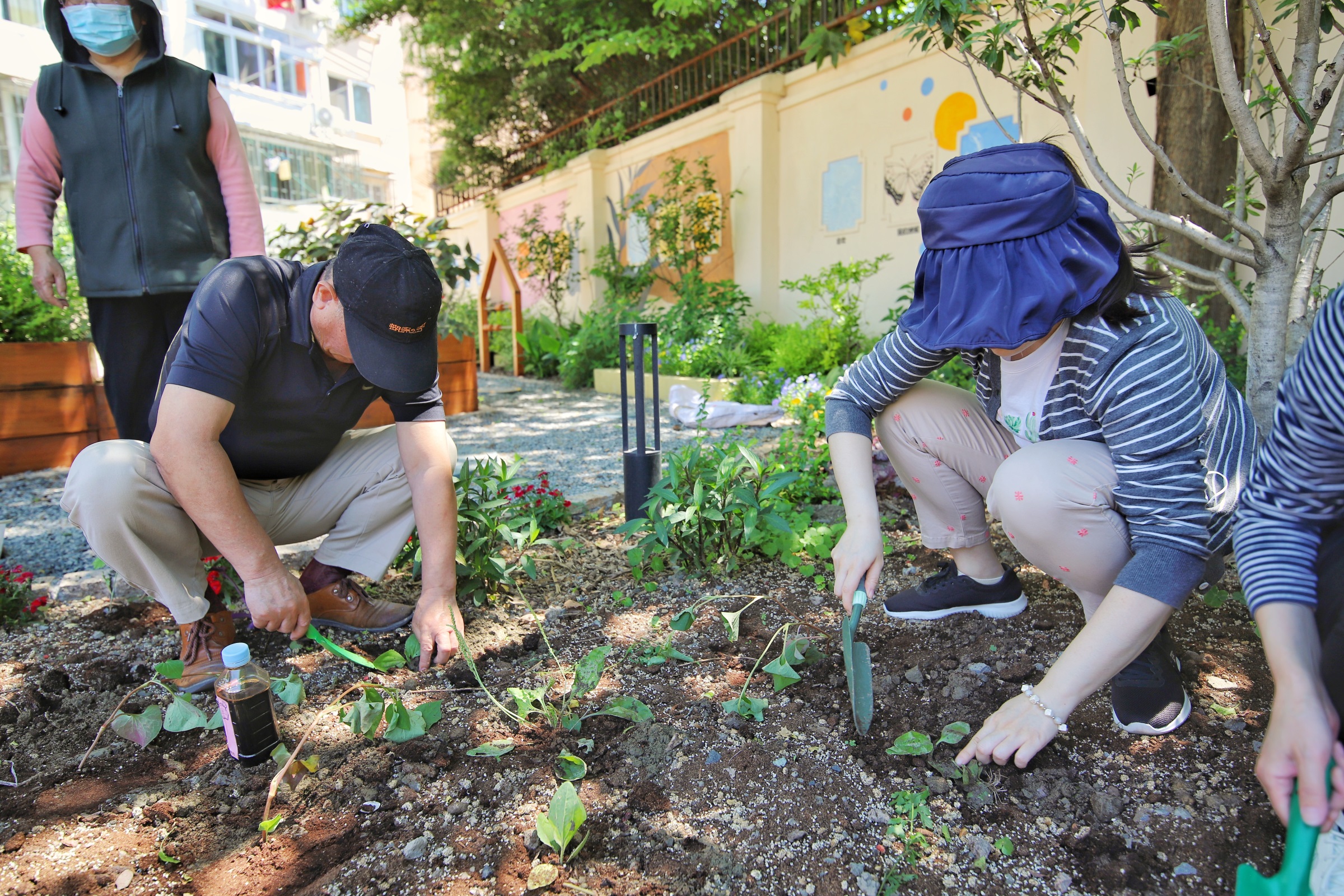本文由 上海四叶草堂/泛境景观设计 授权mooool发表,欢迎转发,禁止以mooool编辑版本转载。
Thanks Shanghai Clover Nature School & Pandscape Design for authorizing the publication of the project on mooool, Text description provided by Shanghai Clover Nature School & Pandscape Design.
四叶草堂/泛境景观:城市化越来越快的今天,我们身边有密密麻麻的高楼、汽车、人,四通八达的道路交通,与此同时,城市里原本的野生动植物栖息地却面临着丧失、破碎化、结构简单、外来物种入侵等很多问题,城市野生动植物数量正在逐渐减少,许多物种甚至已经从城市里消失了。基于一种让更多城市生活人群找回自然共鸣的假设,我们尝试在城市中结合着人的需求和动物生存空间设计营造了虹旭生境花园。
Shanghai Clover Nature School & Pandscape Design: Nowadays, with the rapid urbanization, we are surrounded by high-rise buildings, cars, people and road traffic in all directions. At the same time, the original wildlife habitats in the city are facing many problems, such as disappearance, fragmentation, simple structure, invasion of alien species and so on. The number of urban wildlife is gradually decreasing, and many species have even disappeared from the city. Based on the assumption that more urban people can find natural resonance, we try to design and build Hongxu habitat garden combining human needs and animal living space in the city.
项目概况 Project overview
项目位于上海长宁区仙霞新村街道虹旭小区,这是一个上世纪90年代的典型老式公房小区,场地位于小区南侧边角地,空间隐蔽,是小区拆违后得到的一块消极空间。设计初期现场调研中陆续发现了白头鹎、乌鸫、赤腹松鼠等野生动物在此栖息停留,周边资源环境的调查后,我们发现这里其实靠近上海动物园和外环绿带,生态基底良好,它可以成为很好的一个链接这两个生态斑块的廊道或者中转站。在这样的基础上,能够营造一个自然安静和轻度活动的场所,所以考虑打造成结合着生境功能的社区花园。
The project is located in Hongxu community, Xianxia new village street, Changning District, Shanghai. This is a typical old-fashioned public housing community in the 1990s located in the south corner of the community. It is a hidden and negative space after the demolition of the community. In the initial stage of the design, we found that wild animals such as Pycnonotus sinensis, Turdus merula and Callosciurus erythraeus live here. After the investigation of the surrounding resources and environment, we found that it is close to the Shanghai Zoo and the outer ring green belt, with a good ecological base. It can be a good corridor or transit station linking the two ecological patches. On this basis, it is possible to create a natural, quiet and light activity place, so we consider building a community garden with habitat function.
▼改造前 Before transformation
改造策略 Transformation strategy
场地面积不大,但需留出充足的空间作为鸟类、松鼠及昆虫的栖息停留场所,同时作为社区公共用地,需满足一定程度上的居民活动需求。所以整体思路为“人工形态向自然原生的过渡 ”, 重视居民活动的需求,同时将南侧小三角完全交还给自然,作为目标物种的栖息地或停留地,不设人行空间,人只能在旁观察、学习。
Although the area of the site is small, sufficient space should be set aside for birds, squirrels and insects to live and stay. At the same time, it should be used as community public land to meet the needs of residents’ activities to some extent. Therefore, the overall idea is “the transition from artificial form to natural origin”, paying attention to the needs of residents’ activities. At the same time, the southern small triangle area is completely returned to nature as the habitat or residence of the target species. There is no pedestrian space, and people can only observe and learn.
▼自然科普休憩区 Nature and science resting area
在植物设计部分,完全保留了场地内原有的乡土树种,包括柳树、构树等,并与隔壁小区水杉、紫叶李、桂花树等树冠相连合成整体,打造鸟类与松鼠的活动空间。另外,在新增植配时,尽量配置乡土物种,给本土生物提供食源及庇护所,包括乌桕、蓬蘽、枸骨、枸杞等。
自然科普休憩区用明亮的色彩入口地绘将人群吸引至花园,在靠近现状柳树与北侧围墙一侧的位置设置部分木质平台,作为居民休憩活动的主要区域。高耸的柳树展示场地精神,与廊架合二为一。
In the part of plant design, the original native tree species in the base, including Salix babylonica and Broussonetia papyrifera, are completely retained, and are connected with the canopy of Metasequoia glyptostroboides, Prunus yedoensis and Osmanthus fragrans in the next neighborhood to form a whole, creating a space for birds and squirrels. In addition, local species should be allocated as much as possible to provide food sources and shelters for local organisms, including Sapium sebiferum, Rubus hirsutus, Ilex cornuta, Lycium chinensis, etc.
Nature and Science resting area: Entrance with bright color was created to attract the crowd to the garden. Some wooden platforms near the existing willow trees and the north wall are the main area for residents’ leisure activities. The towering Salix babylonica showing the spirit of the venue integrates with the gallery.
▼保留的柳树展示场所精神 The Salix babylonica showing the spirit of the venue
▼廊架效果 Gallery effect
为增加趣味性,廊架设计了两种尺度,一种是正常成年人休憩的尺度,一种则是儿童尺度,打造一个小型的儿童秘密基地,彩色的通行小门与户外黑板增加了有限空间内的可玩性,也践行着团队一直提倡的“儿童友好”理念。
In order to increase the interest, the gallery is designed with two scales, one is the scale of normal adults for their resting, the other is the scale of children, to build a small children’s secret base. The colorful access door and outdoor blackboard increase the playability in the limited space, and also practice the concept of “Children Friendly” advocated by the team.
▼儿童尺度廊架的户外黑板 Outdoor blackboard with the scale of children
木平台一旁设置小面积的儿童游乐场地,松填材料为软质、可自然分解的树皮,器材选用原生态的木材,如木风琴、平衡木等亲子互动设施,可吸引人气、丰富活动。同时通过解说牌、互动设施等形成儿童与自然交互的空间,使儿童得到心理与智力的自然启发。
A small area of children’s playground is set beside the wooden platform. The loose filling material is soft and naturally decomposable bark. The parent-child interaction facilities are made of original wood, such as wood organ, balance beam and so on, which can attract people and enrich activities. At the same time, the interactive space between children and nature is formed through the explanation board and interactive facilities, so that children can get the natural inspiration of psychology and intelligence.
▼儿童游乐场地 Children’s playground
与树皮坑相接的地方是一个游戏广场,透水混凝土铺装,以彩色地绘装点,主题也与蜜蜂等动物相关,尽可能使小小的场地物尽其用。
The place connecting with the bark pit is a game square, which is paved with permeable concrete and decorated with colored drawings. The theme is also related to bees and other animals, so as to make the best use of the small site.
▼游戏广场 Game square
互动体验区在场地北侧光照较好的区域,满足城市居民体验农事与园艺的需求,让孩子们亲手参与劳作与收获,感受四季变迁,知晓食物来源。
The interactive experience area is located in the area with good illumination on the north side of the site, meeting the needs of urban residents to experience farming and gardening, allowing children to participate in labor and harvest, experience the changes of four seasons, and understand the source of food.
▼种植体验区 Planting experience area
变形的“一米菜园”种植盒高低错落,以种植蔬菜为主,同时搭配香草进行多样化种植;通行空间采用经济透水的砾石,圆形汀步则以鸟类、昆虫、花草、植物等为主题,结合后期社造活动打造涂鸦汀步,增加场地科普与趣味性。
The deformed “one-meter garden” planting boxes are strewn at random, mainly planting vegetables, and planting herbs in a variety of ways; the traffic space is made of economic permeable gravel, and the circular steps are themed with birds, insects, flowers, plants and so on, as well as some graffiti steps created from the social activities, to increase the science and interest of the site.
结合廊架还设置了园艺工作台、工具箱等种植配套区域,便于社区居民操作与管理;设置残疾人种植箱,发挥园艺的疗愈功能。
Some planting supporting areas such as gardening workbench, toolbox and so on are set up combined with the corridor, to facilitate the operation and management of community residents. Moreover, planting boxes for the disabled are set up to play the healing function of gardening.
▼残疾人种植箱 Planting boxes for the disabled
▼结合一米菜园设计的休憩座椅 Rest seats designed combining with one-meter gardens
设置雨水收集桶承接廊架顶部雨水,可作为自治种植区的部分灌溉水源,同时展示了水资源的可持续利用。在西侧围墙附近设置小块堆肥区域,尽量展示堆肥的过程,起到消化厨余、在地处理花园废弃物及科普宣传的作用。
The rainwater collection bucket is set to receive the rainwater which can be used as part of the irrigation water source in the autonomous planting area from the top of the rack. It shows the sustainable utilization of water resources. A small composting area is set up near the west wall to show the composting process as much as possible, so as to digest kitchen waste, treat garden waste in the ground and promote science popularization.
▼雨水收集系统 Rainwater collection system
自然栖息保护区主要针对前期调研观察到的目标物种,综合设计其所需的食源、水源及庇护所。除必要修剪维护外尽量不让人踏足进入。
The natural habitat protection area mainly aims at the target species observed in the previous investigation, and comprehensively designs the food source, water source and shelters to meet their needs. Except for necessary pruning and maintenance, people should not be allowed to enter as far as possible.
▼自然栖息保护区 Natural habitat reserve
水是生命的源泉。作为自然栖息保护区的核心,水塘位于半阴半阳处,边坡平缓,坡度小于1:1,以块石与碎石垒叠驳岸,营造粗糙多孔的界面,可作为蛙类及昆虫等动物的上下通道与躲避场所;水塘的不同深度可满足不同习性动物的水源要求。岸边配植水生植物,在净化水质的同时,能为水生动物提供庇护所、繁殖地和食物来源。
Water is the source of life. As the core of the natural habitat reserve, the pond is located in the semi shade and semi sunny place, with gentle slope less than 1:1. The revetment is made of block stone and gravel to create a rough and porous interface, which can be used as a passageway and shelter for frogs, insects and other animals. The different depths of the pond can meet the water requirements of different habits of animals. Aquatic plants on the shore can purify water quality and provide shelters, breeding places and food sources for aquatic animals.
▼生态池塘,为蛙类、蜻蜓豆娘等提供栖息和繁衍的空间 The pond provides a space for frogs and dragonflies to inhabit and reproduce
为方便鸟类喝水、洗澡时不容易被天敌盯上,在水塘附近补充种植了小乔与灌木,植物冠缘相接形成鸟类出入的屏障通道。同时挑选了鸟类喜爱的食源植物与叶片宽大适合筑巢的植物丰富群落,还考虑冬季结果的植物能提供鸟类的“过冬粮”,花多浓香的植物能吸引食蜜类鸟类与昆虫。
In order to make it easier for birds to drink and bathe without being watched by natural enemies, small trees and shrubs were planted near the pond, and the plant crown edge was connected to form a barrier channel for birds to move. At the same time, the food source plants favored by birds and the plant rich communities with wide leaves suitable for nesting were selected. It was also considered that the winter bearing plants could provide “winter food” for birds, and the plants with fragrant flowers could attract honey-eating birds and insects.
▼授粉昆虫 Pollinating insects
靠近东侧的区域种植香花香草类植物,撒播野花草甸,作为蝴蝶等昆虫的食源或寄主植物,营造小范围昆虫生境。
针对不同习性的昆虫营造它们可能所需的栖息地:如水塘一侧的粗砾沙地,水泥块填充的石笼围成的环形花池,以及定制的特色昆虫箱,能提供大小、密度不同的空洞与介质成为特定昆虫的庇护所,或护其过冬。
In the area near the East, vanilla plants are planted and wildflower meadows are sown to serve as food sources or host plants for insects, such as butterflies, so as to create a small-scale insect habitat.
Different habitats may need to be built for different insects: for example, the coarse gravel sand on one side of the pond, a circular flower pool surrounded by stone cages filled with cement blocks, and the custom-made special insect box, which can provide holes and media of different sizes and densities to become a shelter for specific insects or protect them for the winter.
该区域在自然保育之外,也穿插了一些自然科普功能。
选择合适的位置设置观鸟点,尽量在不影响鸟类生活的前提下增加自然观察空间。并配备专业红外相机持续跟踪记录花园建成对鸟类及其它生物的积极作用。植物吸引来的昆虫也能成为社区孩子们的自然观察样本。
In addition to nature conservation, the area also has some functions of science popularization.
The right places are chose to set up bird watching point, the natural observation spaces are increased without affecting the life of birds, and professional infrared camera is equipped to track and record the positive effect of the garden on birds and other creatures. Insects attracted by plants can also serve as natural observation samples for children in the community.
▼复旦大学王放老师团队布设的红外相机 Infrared camera is equipped by Wang Fang’s team of Fudan University
▼红外相机拍到的黄鼬 Mustela sibirica captured by infrared camera
场地周边三面高墙在上海大学上海美术学院公共艺术工作室等合作伙伴的助力下,结合城市常见的动植物,将其用一种相对艺术的形式展现给社区居民,用相对明快鲜亮的色彩优化了立面景观空间。
With the help of the public art studio of Shanghai Academy of Fine Arts, Shanghai University and other partners, the three high walls around the site are presented to the community residents in a relatively artistic form in combination with the common animals and plants in the city, and the facade landscape space is optimized with relatively bright colors.
▼动物主题墙绘 Wall painting with animal theme
社区营造 Community empowerment
为了充分激活场地的完全功能,创造一种“社区花园+”的生活,我们围绕着场地主要贯彻社区营造和居民参与的理念,同时这里是“兼具栖息地功能”的花园,即花园具有生境功能,能够为野生动物提供食源、水源和庇护所等生存环境;利用这种形式,让大家可以在家门口参与园艺种植、休闲交流、健身疗愈、自然观察等类型丰富的体验活动。
In order to fully activate the full function of the site and create a life of “Community Garden +”, we mainly implement the concept of community empowerment and residents’ participation around the site. At the same time, this is a garden with “Habitat Function”, which can provide food, water and shelters for wild animals. By using this form, people can participate in a variety of experience activities such as gardening, leisure exchange, fitness therapy, nature observation and so on close to home.
虹旭生境的落地实施,意味着我们通过整合多方资源、合作共享的方式探索出在社区空间中积极营造城市生物多样性的可能,同时结合我们在社区营造的探索实践,积极发动居民参与,形成可持续参与的花园管理机制。
在这个社区花园改造完成之后,为了让社区居民们能够更好地认识、使用、维护这个花园,虹旭居委、大自然保护协会(TNC)与我们开始策划组织一系列的居民参与活动,为社区志愿者积极赋能,先后开展志愿者培训、公民科学家讲座、一米菜园种植、生态堆肥、自然观察技巧讲解等活动,让居民可以多维度地了解这个社区花园的丰富功能。
The implementation of Hongxu habitat means that we explore the possibility of actively building urban biodiversity in community space through integrating multi-party resources, cooperation and sharing. At the same time, we actively mobilize residents’ participation and form a sustainable garden management mechanism in combination with our exploration and practice in community empowerment.
After the renovation of the community garden, for community residents’ better understanding, use and maintenance of the garden, Hongxu neighborhood committee and the Nature Conservation Association (TNC) began to plan and organize a series of residents’ participation activities with us, so as to actively empower the community volunteers, including volunteer training, citizen scientist lectures, one-meter garden planting, ecological composting, natural observation skills explanation and other activities, so that residents can understand the rich functions of the community garden from multiple dimensions.
▼TNC 伙伴特别邀请 Bambu 主理人 Rachel 女士与 Jeff 先生作主题为“可持续生活”的演讲 TNC partners specially invited Ms. Rachel and Mr. Jeff, the director of Bambu, to give a speech on the theme of “sustainable life”
在系列活动中,居民们逐渐认识到这个花园的价值,在不断参与中增强了跟社区花园的黏度。这次疫情,更是让大家不断反思跟自然的关系,让我们更加深刻地意识到与自然和谐相处的方式,积极践行可持续生活,照顾地球,因此在世界地球日这天,我们通过设计“生态池营造”的活动,让大家更加清晰地认识在花园中生态池的重要作用,通过种植丰富的水生植物让水体具有自净功能,减弱大家因为认知模糊而产生的质疑,比如容易长蚊子、发黑变臭、对小孩产生危险等问题。
In a series of activities, the residents gradually realized the value of the garden, and enhanced the viscosity with the community garden in the continuous participation. Moreover, the Covid-19 epidemic makes us constantly reflect on the relationship with nature, and make us more deeply aware of the way to live in harmony with nature, actively practice sustainable life, and take care of the earth. Therefore, on World Earth Day, we organized the activity of “Ecological Pool Construction”, so that we can more clearly understand the important role of ecological pool in the garden, and plant rich aquatic plants to make the water body self-cleaning, and weaken the doubts caused by people’s vague cognition, such as more mosquitoes, black and smelly, and dangerous to children.
改造后的生物多样性 Biodiversity after transformation
在虹旭生境花园中,有干净的水源、丰富的食源、安全的庇护所,而且这里种植了大量的乡土植物,如桑树、构树、乌桕、竹叶花椒、接骨木、蓬蘽等,尽可能保证植物的选择具有较高的适应性较和不具有入侵性。营造完成后,鸟儿及动物们很快在此安家,在这里已经观察监测到白头鹎、乌鸫、珠颈斑鸠、麻雀、北红尾鸲、暗绿绣眼鸟、黄腰柳莺、红胁蓝尾鸲、鹊鸲、白眉鸫、灰喜鹊、凤头鹰等10多种鸟类,还有赤腹松鼠、黄鼬等哺乳动物。跟复旦大学王放老师合作监测的红外相机清楚拍摄到黄鼬在此穴居、外出觅食等生活行为,居民们每次到花园中都能发现很多鸟类在此喝水、取食、休息,这里已经成为一个在城市中人与自然和谐共处的真正示范空间。
In Hongxu habitat garden, there are clean water sources, rich food sources, safe shelters, and a large number of local plants are planted here, such as Morus alba, Broussonetia papyrifera, Sapium sebiferum, Zanthoxylum bungeanum, Sambucus williamsii, Rubus hirsutus, etc. so as to ensure that the selection of plants has high adaptability and non invasiveness as far as possible. After the completion of the construction, birds and animals soon settled down here. More than 10 kinds of birds, including Pycnonotus sinensis, Turdus merula, Spilopelia chinensis, Passer montanus, Phoenicurus auroreus, Zosterops japonicus, Phylloscopus proregulus, Tarsiger cyanurus, Copsychus saularis, Turdus obscurus, Cyanopica cyanus, Accipiter trivirgatus and mammals, as well as Callosciurus erythraeus and Mustela sibirica, have been observed and monitored here. The infrared camera, which cooperated with Wang Fang of Fudan University, clearly photographed the weasel living in this cave and going out for food. Every time residents go to the garden, they can find many birds drinking, feeding and resting here. It has become a real demonstration space for harmonious coexistence between man and nature in the city.
▼北红尾鸲 Phoenicurus auroreus
值得一提的是,白头鹎是一种非常常见的城市鸟类,我们每天都会被它欢快起伏的叫声叫醒,观察它们的生活行为也非常有趣。由于它们数量多,食性广,适应能力极好,因此在很多被破坏的森林、需要生态恢复的荒地,它们作为很多植物重要的种子传播者,每一只白头鹎的种子传播距离在1公里左右。另外经过我们的观察记录发现,在虹旭小区生境花园的桑树上,每2分钟就有一只白头鹎抓到虫子,1分钟不到完成进食,效率很高,能够很大程度上抑制昆虫的数量。因此白头鹎这样的鸟类在城市生态中可以说是一种重要的鸟类,我们不可忽视它们的生态价值。
It is worth mentioning that Pycnonotus sinensis is a very common urban bird. We are awakened by its cheerful and fluctuating calls every day, and it is also very interesting to observe their life behavior. Because of their large number, wide food habits and excellent adaptability, they are important seed disseminators of many plants in many damaged forests and wastelands that need ecological restoration. The seed transmission distance of each Pycnonotus sinensis is about 1 km. In addition, through our observation and record, we found that on the mulberry tree in habitat garden of Hongxu community, a Pycnonotus sinensis catches insects every 2 minutes, and eats less than 1 minute, which is very efficient and can restrain the number of insects to a great extent. Therefore, birds such as Pycnonotus sinensis are important in urban ecology, and their ecological value should not be ignored.
▼白头鹎捉虫 A Pycnonotus sinensis catches insects
▼赤腹松鼠 Callosciurus erythraeus
除常规社区更新带来的景观空间品质提升外,本项目的落地意义更在于我们利用生态规律与仿生智慧,力所能及的为城市野生动物们提供了一小块栖息地,为周边居民提供了家门口触手可及的生态花园。这个具有生境功能的社区花园从改造完成开始就得到了很多媒体和公众的关注,也作为长宁区城市更新项目之一,有幸获国务院关注及表扬。我们相信,这样的点状生境花园,随着我们不懈的坚持实践及更多人的加入支持,将在未来连成线、连成面,真正帮助到跟我们一起栖息在这个城市中的生物们,以及人类自己。
In addition to the improvement of landscape space quality brought by conventional community renewal, the significance of this project is that we use the ecological regulation and bionic wisdom to provide a small habitat for urban wild animals and provide the surrounding residents with an ecological garden within reach. As one of the urban renewal projects in Changning District, this community garden with habitat function has attracted the attention of many media and the public since the completion of the renovation. In addition, It has been paid attention and praised by the State Council. We believe that with our unremitting practice and the support of more people, this kind of dot habitat garden will be connected into a line and a plane in the future, and will really help the creatures living in this city together with us, as well as human beings.
项目名称:社区花园与城市生境—上海长宁区虹旭生境花园
完成年份:2019年12月
项目面积:占地450平方米
项目地点:上海市长宁区虹旭二小区
设计公司名称:上海四叶草堂青少年自然体验服务中心(简称四叶草堂,CNS) 泛境景观设计
联系邮箱:siyecaotang2014@163.com
项目主创:魏闽博士
项目团队:谢文婉、李杰、丁诗意、廖小平
业主单位:上海市长宁区仙霞新村街道丨虹旭居委会
生境花园战略合作单位:大自然保护协会TNC
墙面美术设计与绘制单位:上海大学上海美术学院公共艺术工作室
施工单位:庶风景观
摄影师: 李杰 董大正(大自然保护协会TNC)
Project name: Shanghai Hongxu Habitat Garden
Completed: December 2019
Area: 450 square meters
Project location: Hongxu 2 Community, Changning District, Shanghai
Design company: Shanghai Clover Nature School & Pandscape Design
Contact email: siyecaotang2014@163.com
Lead designer: Dr. Wei Min
Design team: Xie Wenwan, Li Jie, Ding Shiyi, Liao Xiaoping
Developer: Hongxu Neighborhood Committee, Xianxia Xincun Street, Changning District, Shanghai
Strategic partner: The Nature Conservancy TNC
Wall art design and drawing: Public Art Studio of Shanghai Academy of Fine Arts, Shanghai University
Construction: Shufeng Landscape
Photographer: Li Jie, Dong Dazheng (TNC)
更多 Read more about: 上海四叶草堂/泛境景观设计





































0 Comments